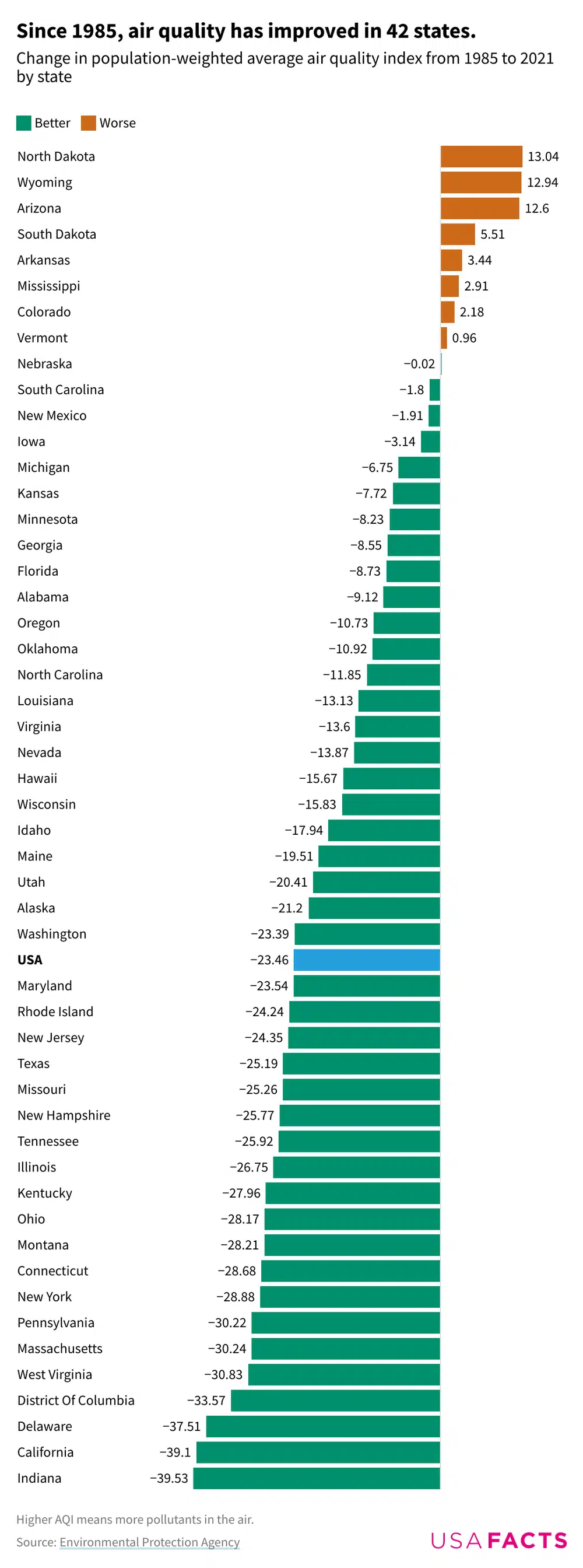The average air quality in Arizona is considered unhealthy, while Hawaii has the country’s best air quality.
These designations are based on air quality index (AQI) which indicates the number of pollutants in the air. According to the Environmental Protection Agency, an AQI of less than 50 is considered “good,” an AQI of 51–100 is “moderate,” and 101–150 is “unhealthy for sensitive groups.”
Which states have the best and worst average AQI?
Forty-three states and Washington, DC, have a healthy average AQI. Hawaii’s is the best (24.2), followed by Alaska (27.9), and Maine (34.8). Arizona is the only state with an unhealthy average AQI, at 101.8. Nationally, the average AQI was 48.6 in 2021.
However, air quality within states can vary significantly. Arizona’s poor air quality can be attributed to the worsening air quality in Maricopa County, which has both the nation’s fastest growing population and the fewest good air quality days. Maricopa County had good air quality on just 4% of days in 2021 (this figure was 25% in 1980). Poor air quality in California is primarily concentrated in Southern California and the Central Valley.
Get facts first
Unbiased, data-driven insights in your inbox each week
You are signed up for the facts!
Air quality is impacted by nitrogen oxide emissions from industrial facilities and vehicles as well as airborne particles such as smoke or dust from vehicles, factories, and fires.
In contrast, most of the country experiences good air quality on most days. Around 96% of counties had good air quality for more than half of days in 2021.
Which states have improving or worsening air quality?
National air quality has improved over the past several decades due to federal and state regulations on vehicles and factories. Since 1985, the national average AQI has improved by 23.5 points. Only eight states have had worsening air quality since then, particularly North Dakota, Wyoming, and Arizona.

Indiana and California have had the greatest air quality improvements since 1985.
Where did this data come from?
Air quality monitoring stations across the country take readings most days during the year. The below county map, which only includes measurements from counties with quality monitors, highlights the underlying difficulties with measuring air quality across a state. Some states, such as Nebraska, have less than 10 air quality monitoring stations to cover the state’s 93 counties. On average, each county has data for 325 days out of the year, but that count can be much lower. Out of the country’s more than 3,143 counties, 990 had any air quality measurements at all, and 921 of them measurements for at least 200 days out of the year.
To get the population-weighted AQI, the average air quality for the year in each county highlighted is calculated. These figures are then weighted according to the population in the county. Counties without data are not included in this measurement.
AQI is population-weighted is to better represent the experience of the average state resident. In Arizona, 62% of the population lives in Maricopa County, so Maricopa County’s AQI has an outsized impact on the state’s AQI.
As the wildfire season lengthens across the country, monitoring air quality will continue to grow in importance.
Learn more about the US environment, how air quality has changed since the Clean Air Act, the cities with the best and worst air quality, and get the facts every week by signing up for our newsletter.







